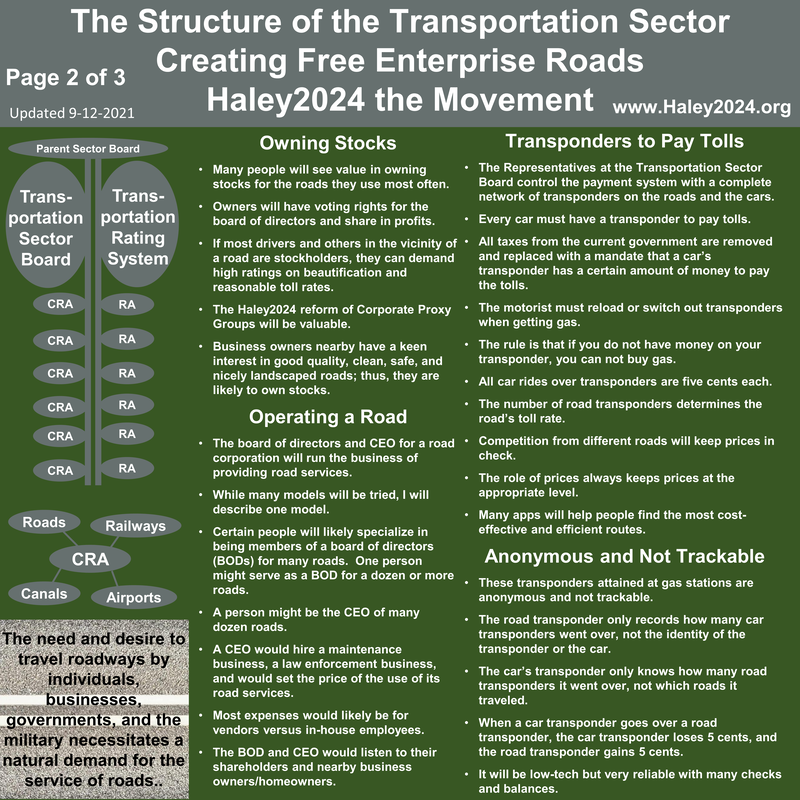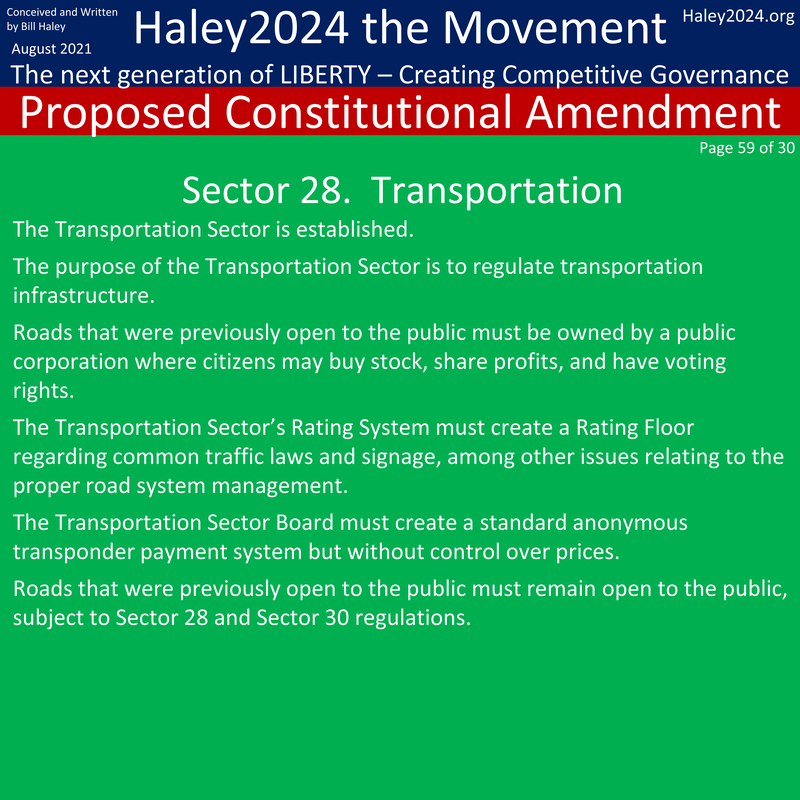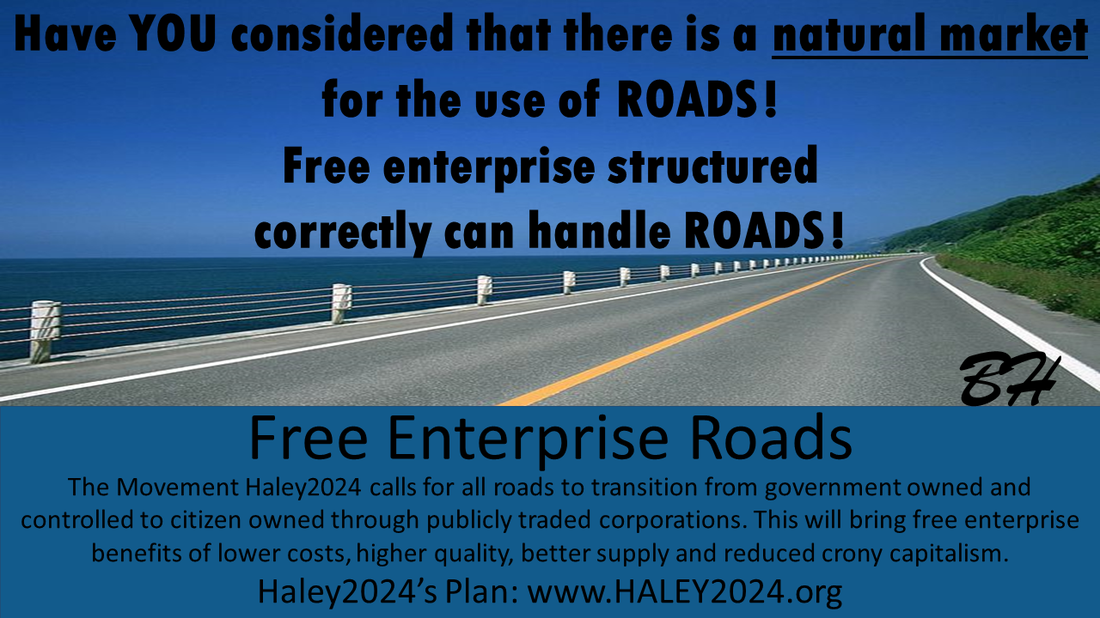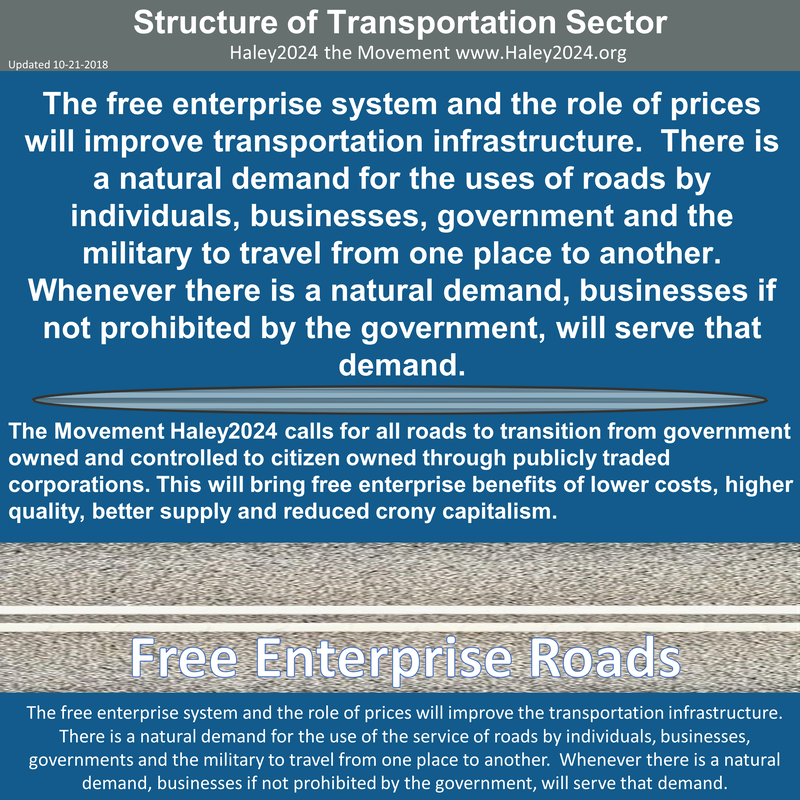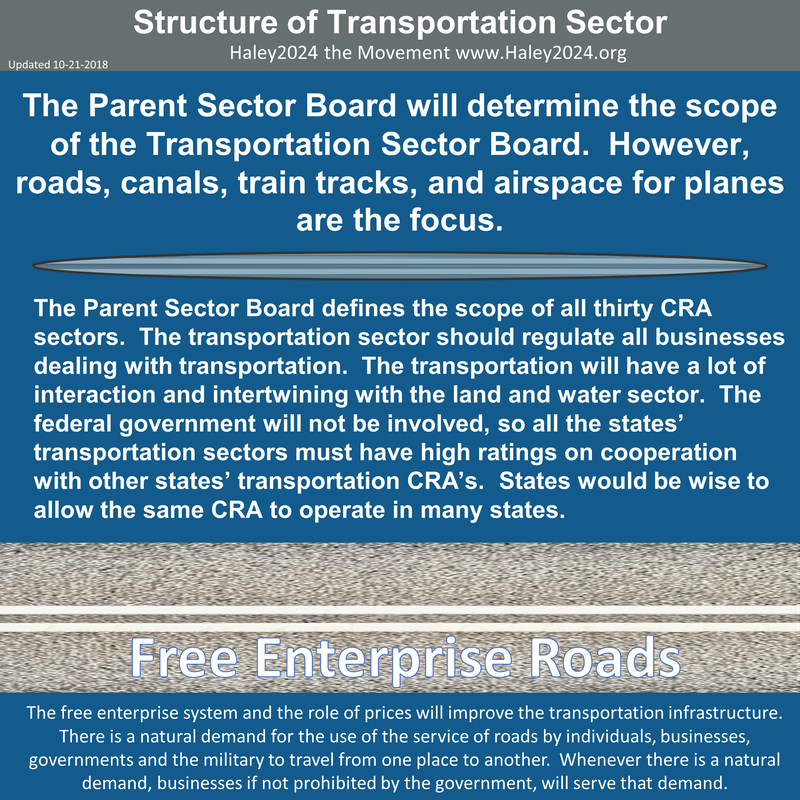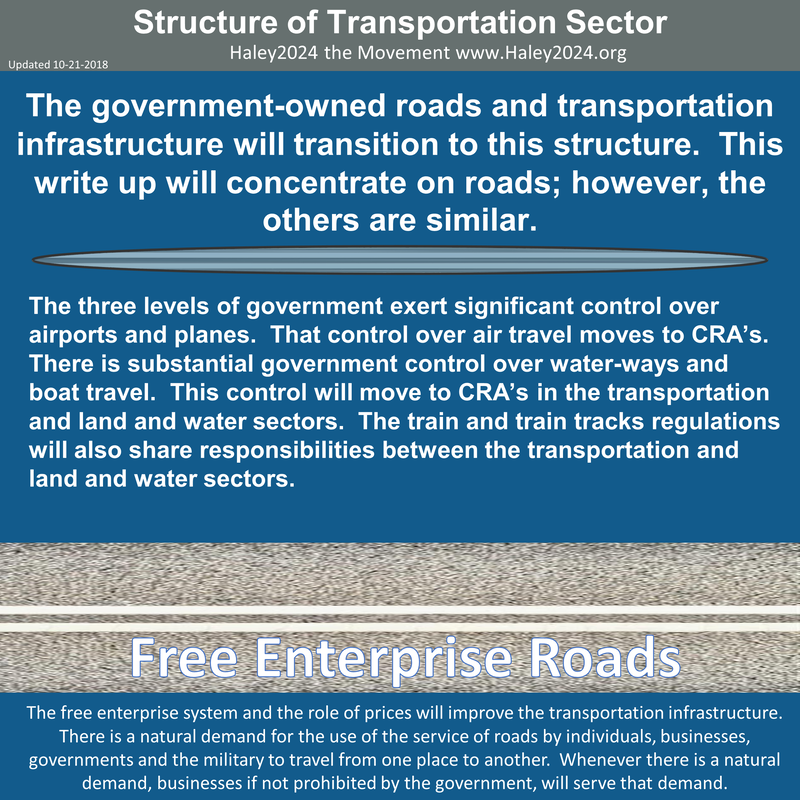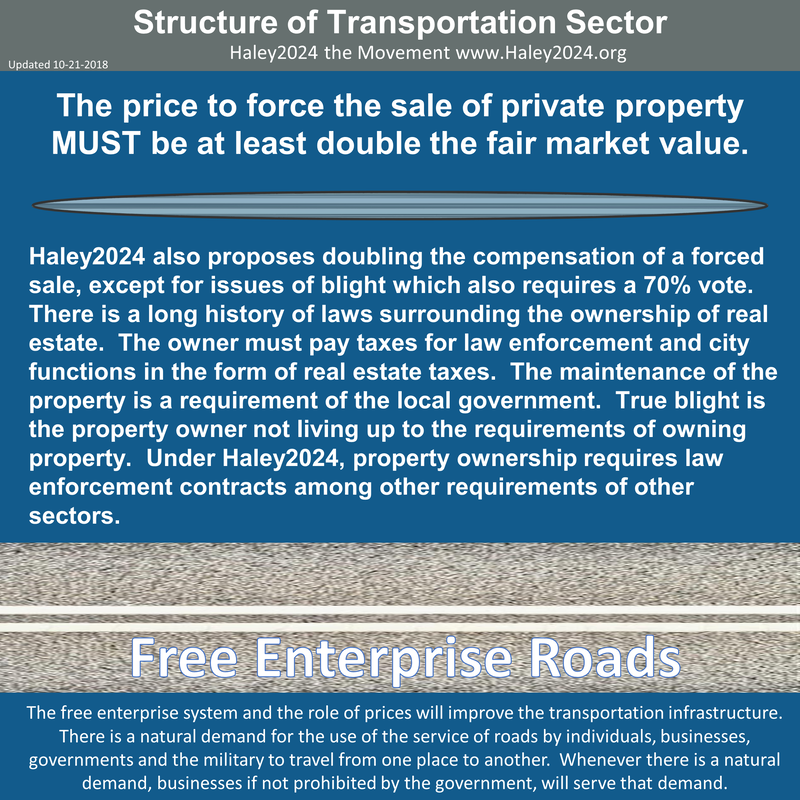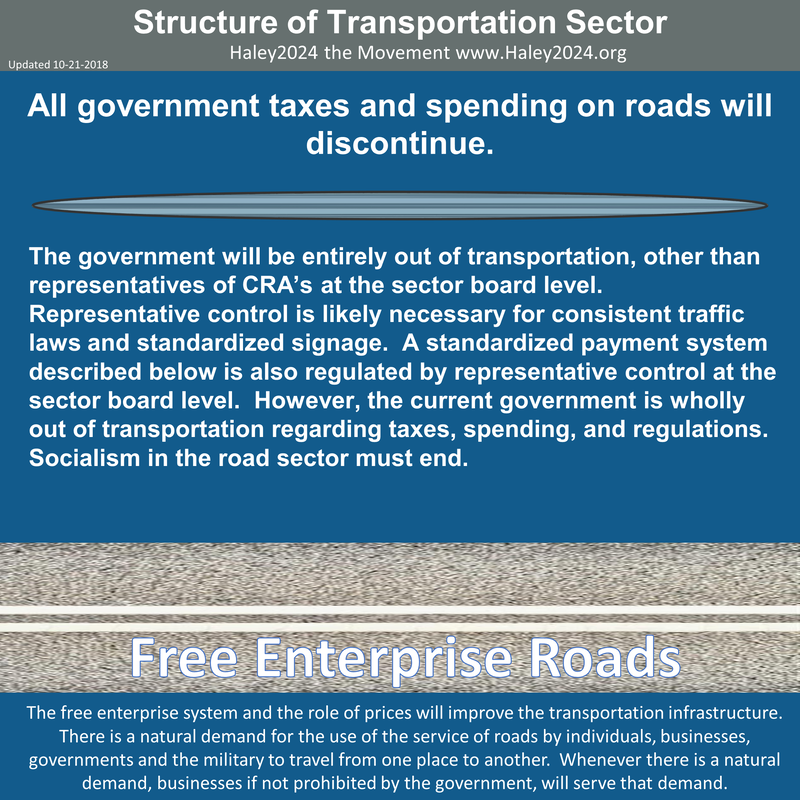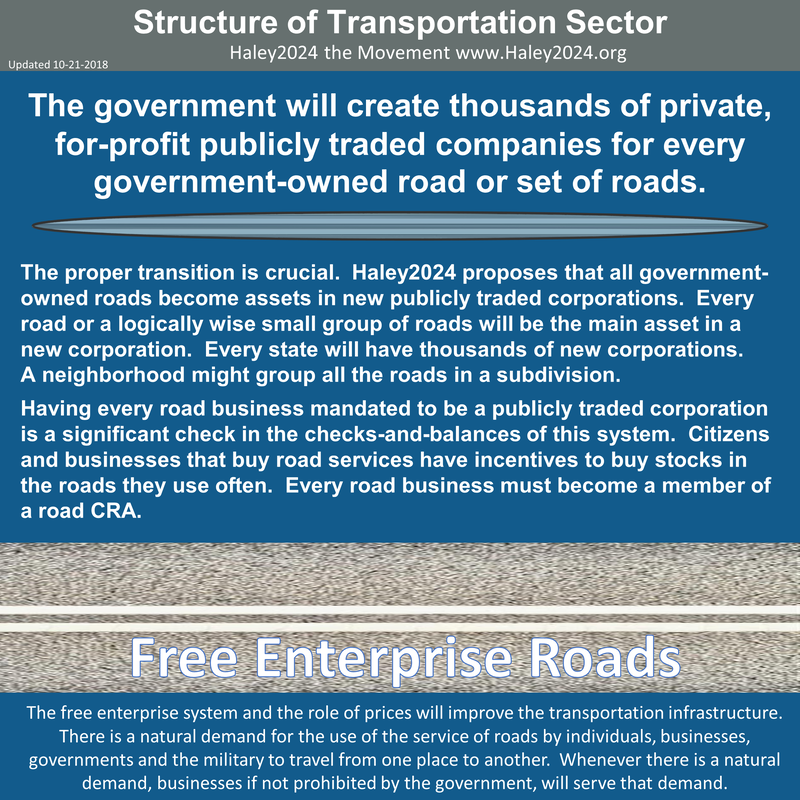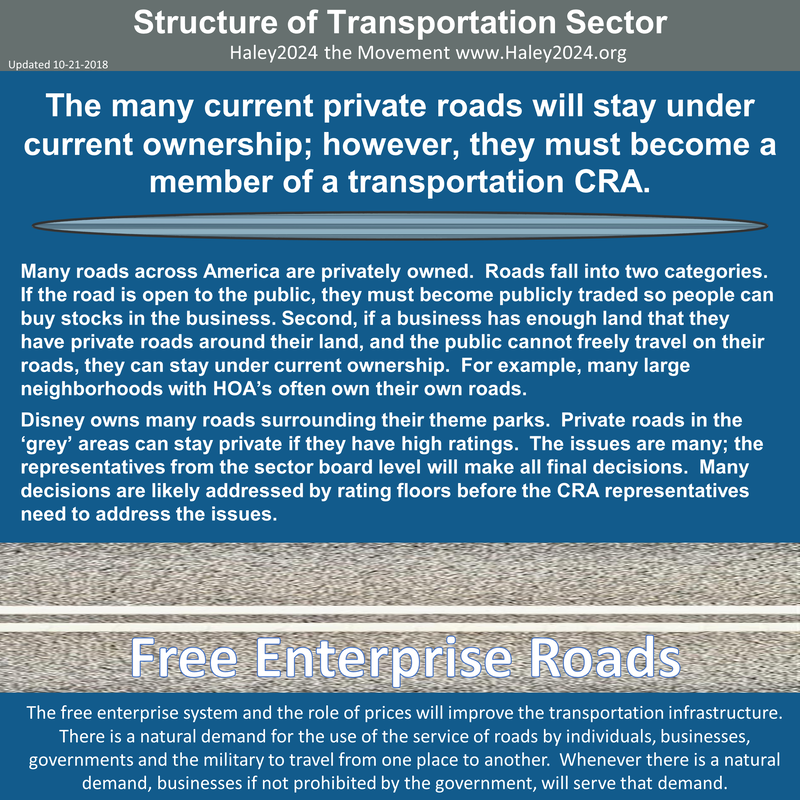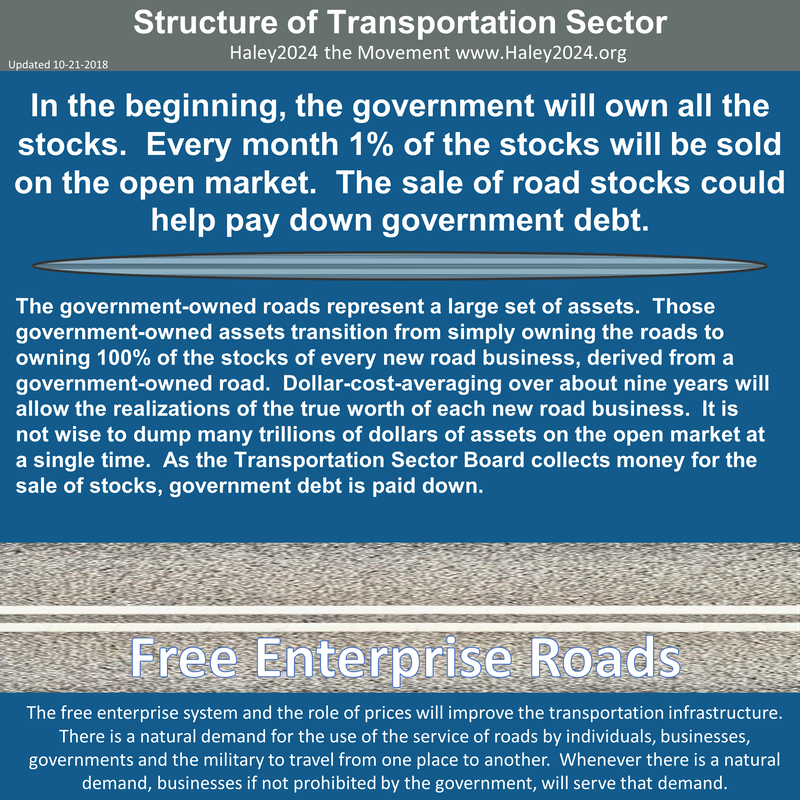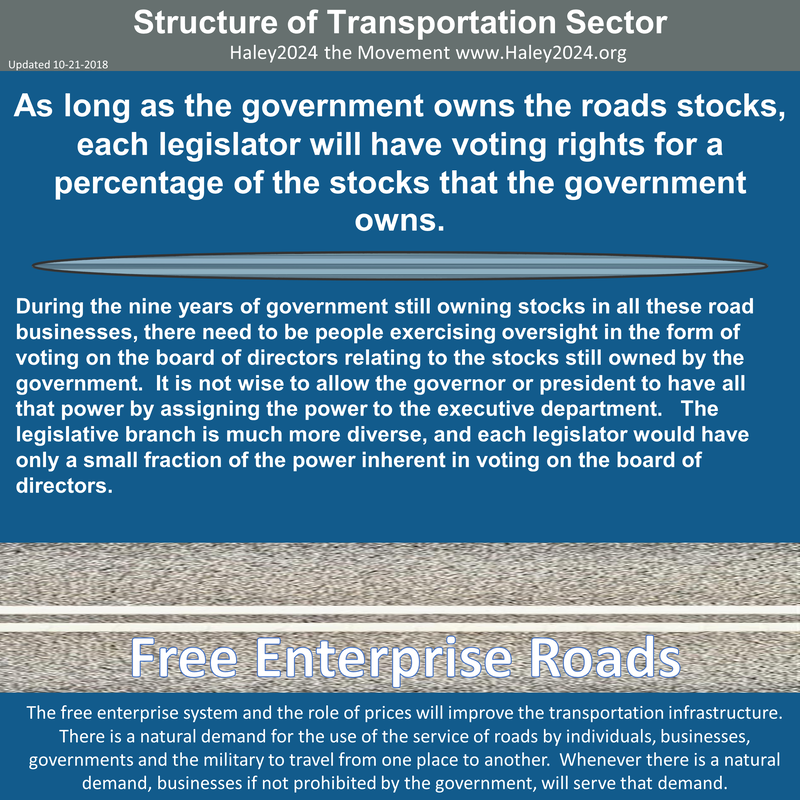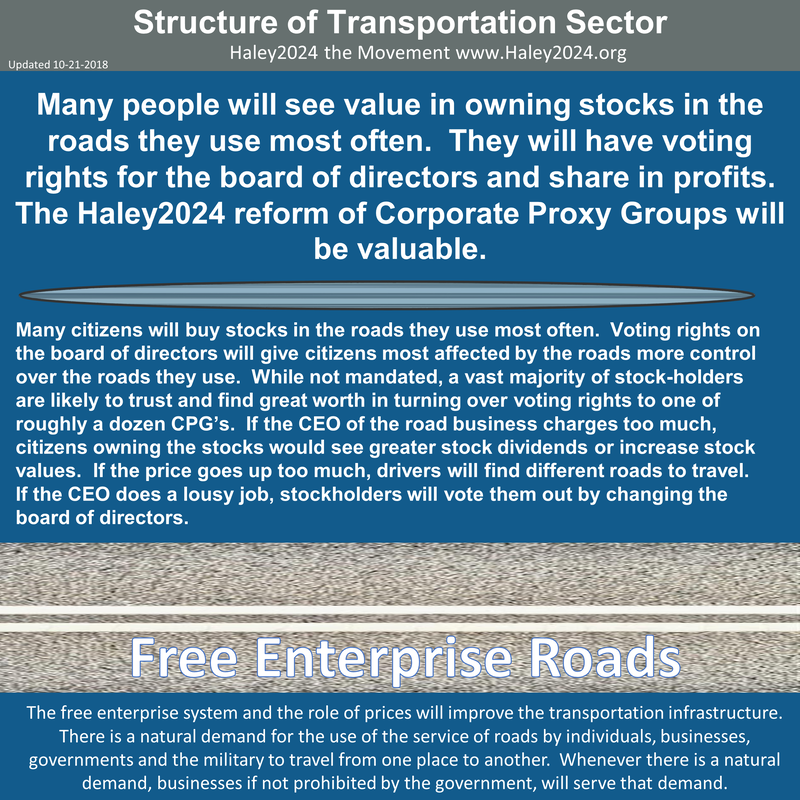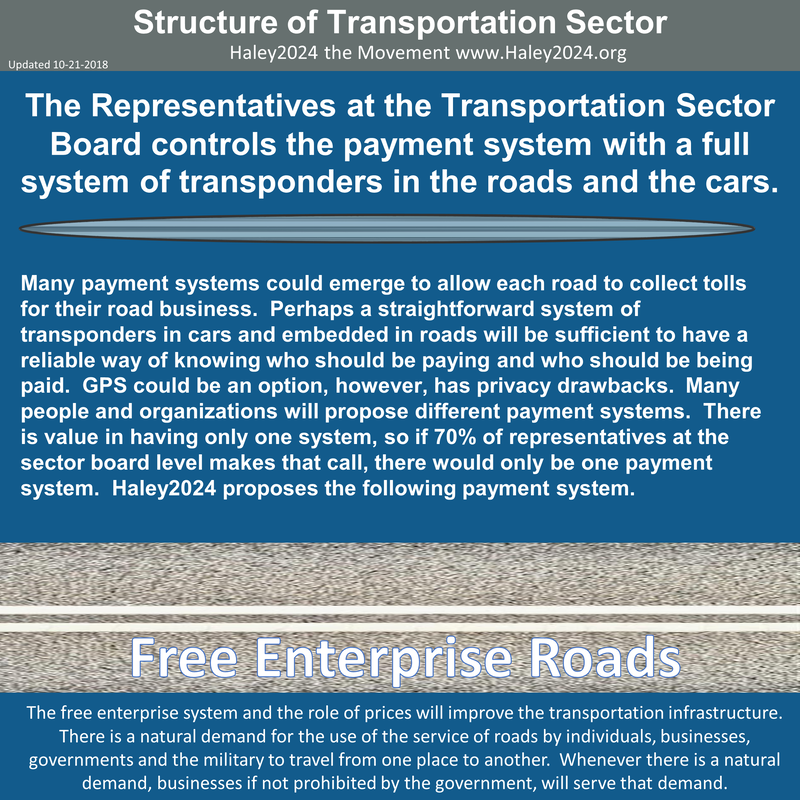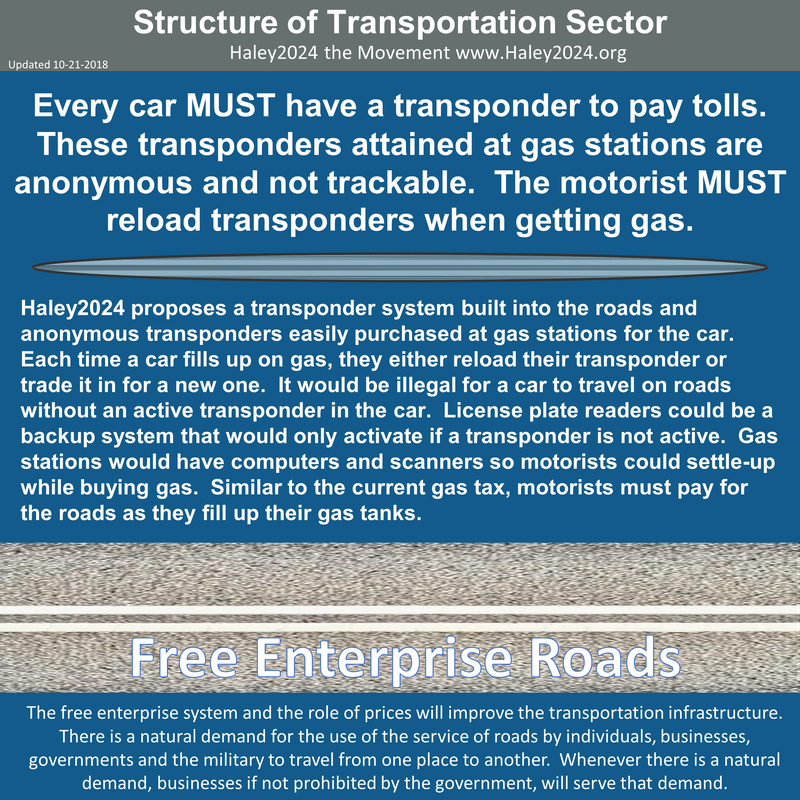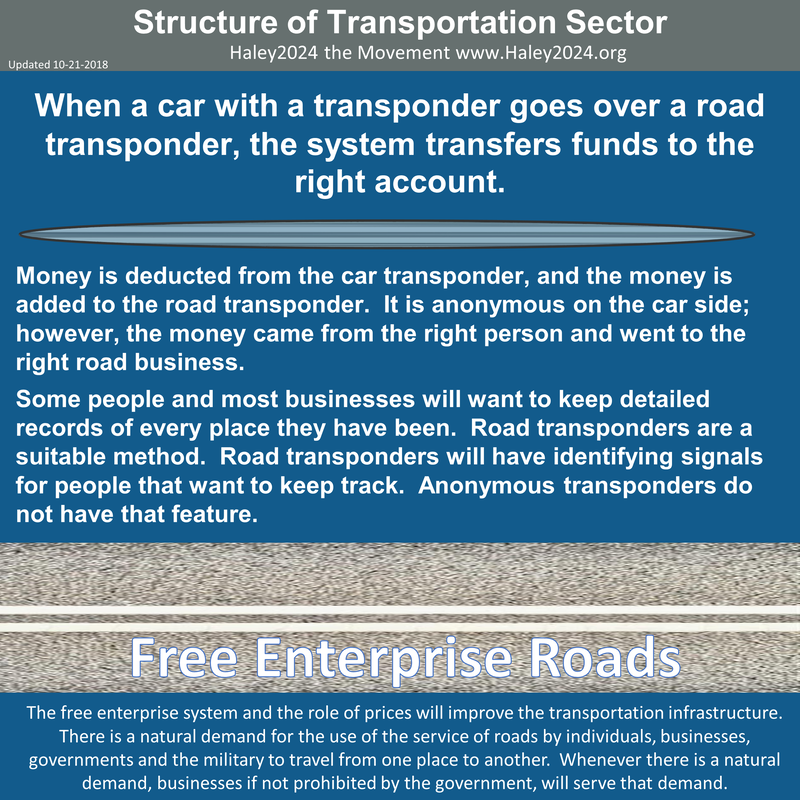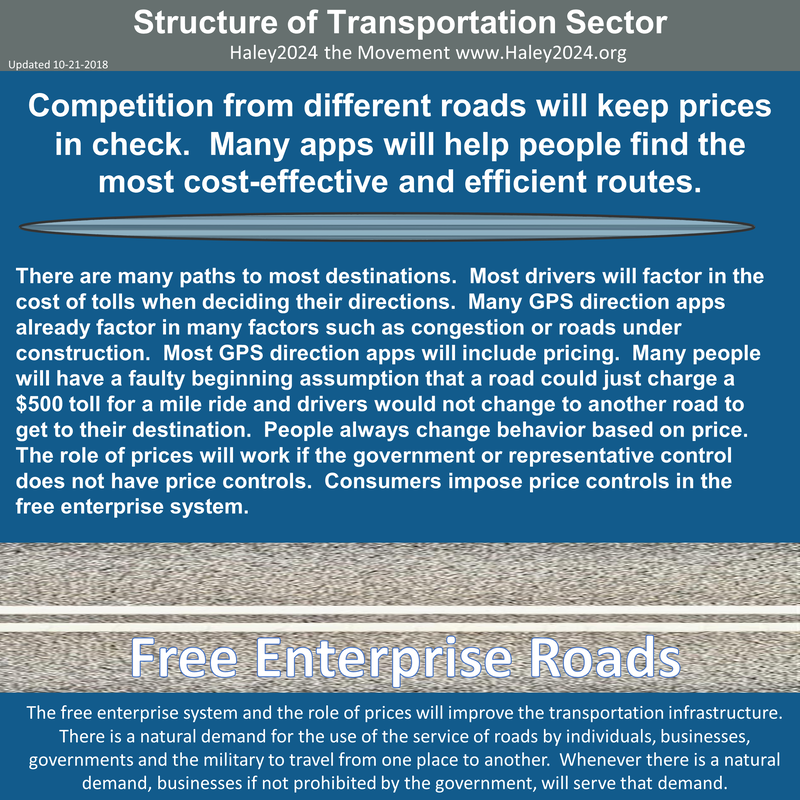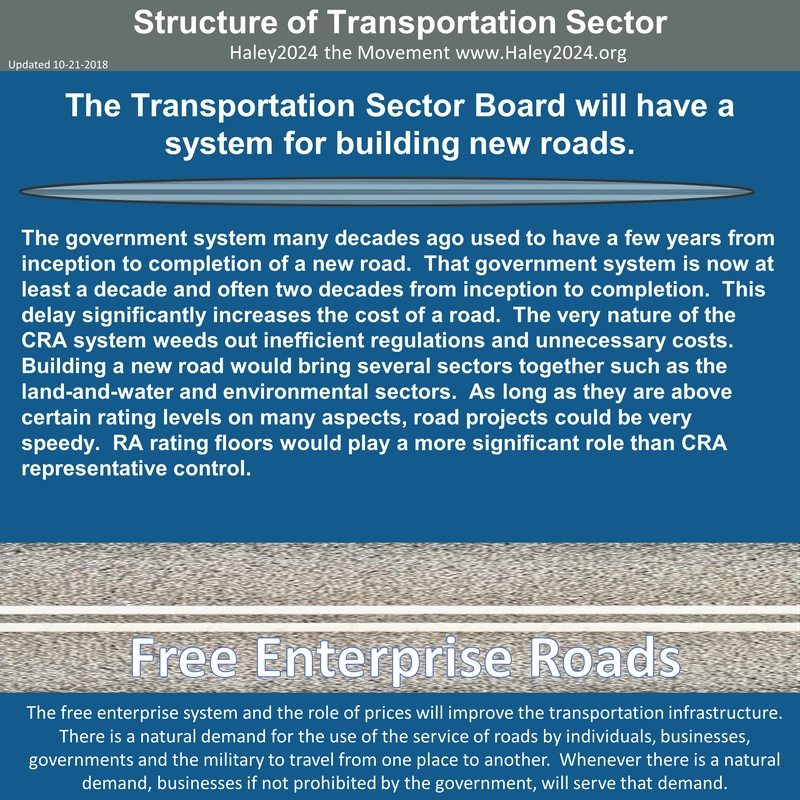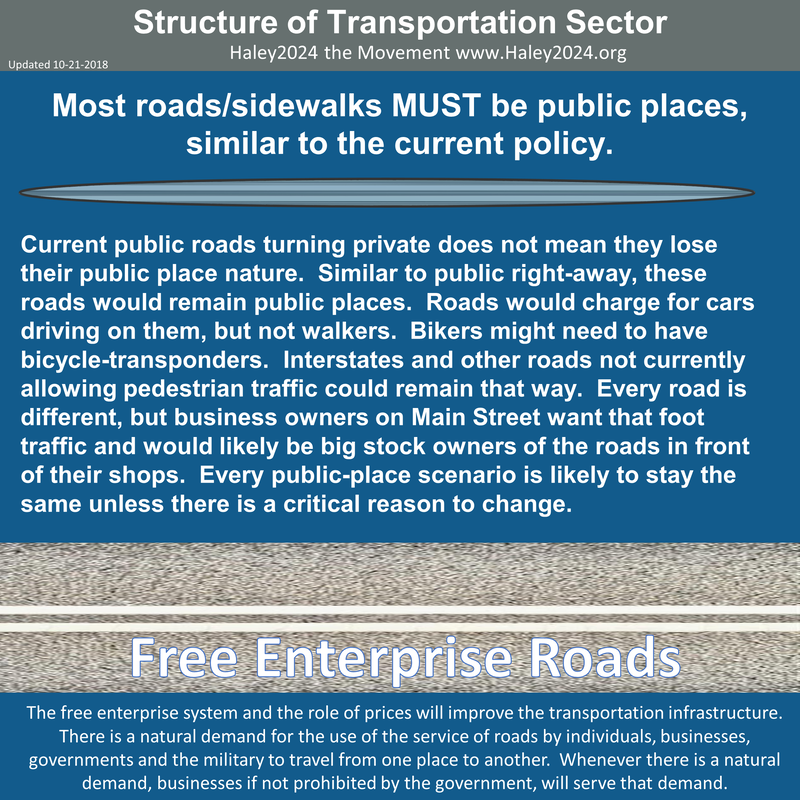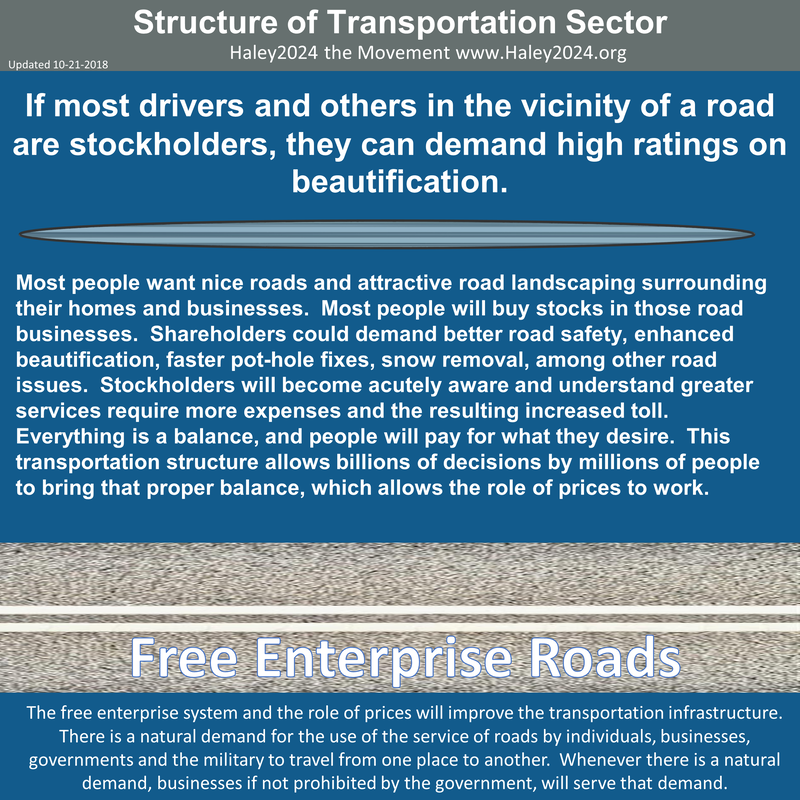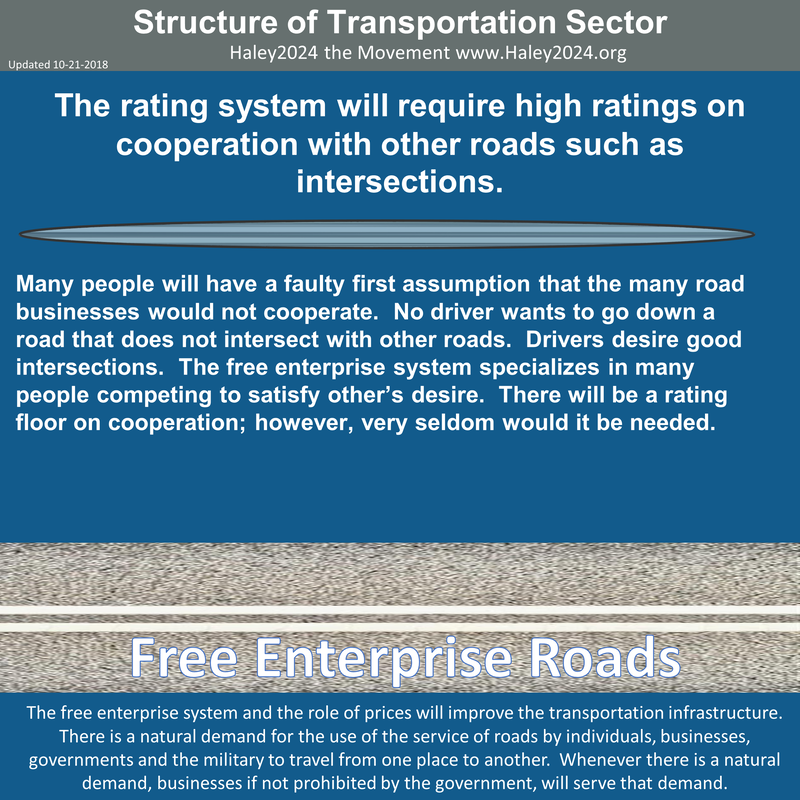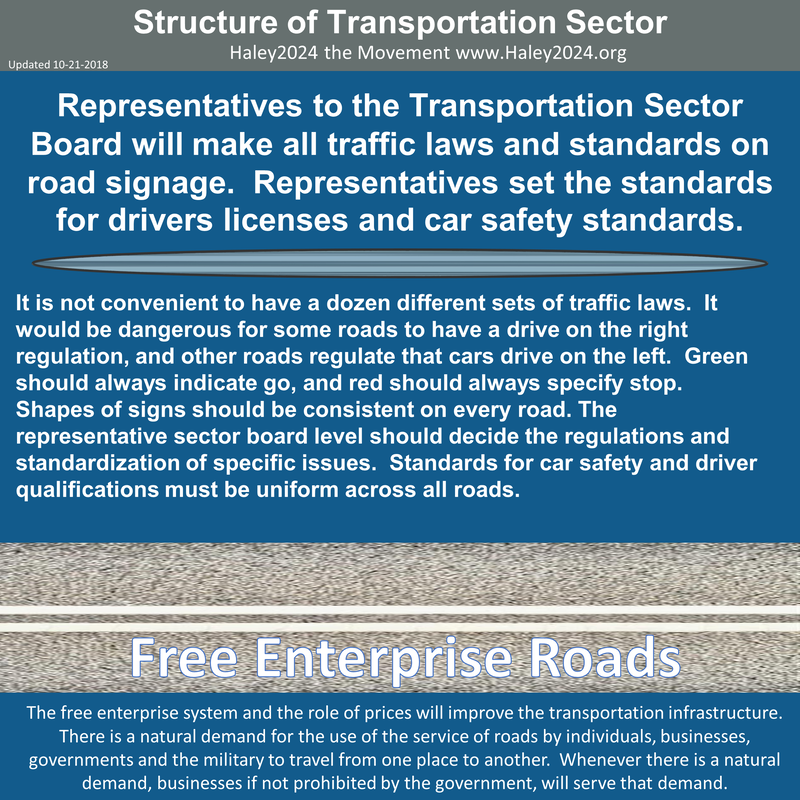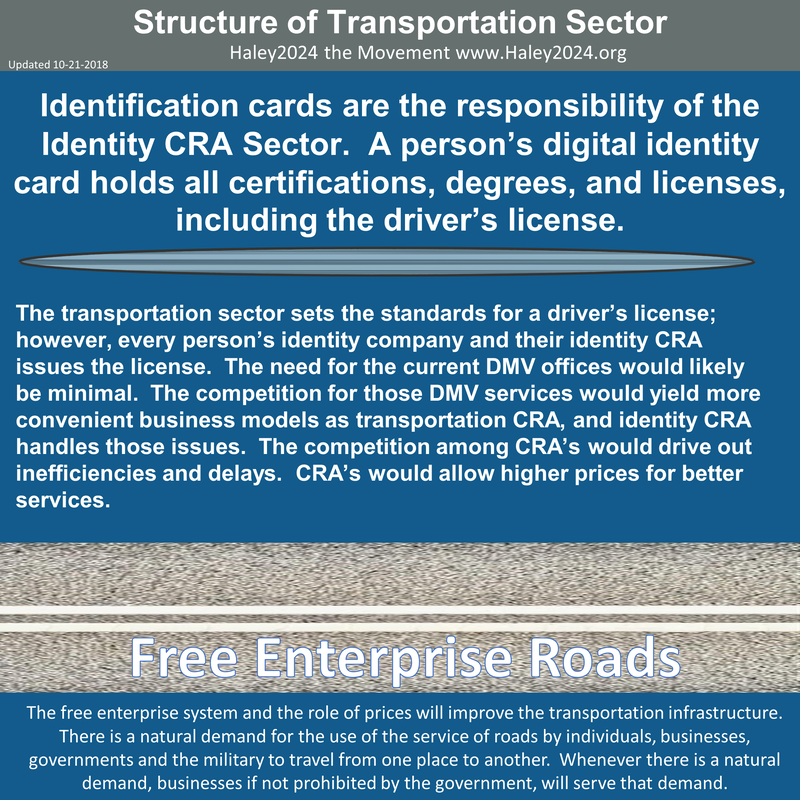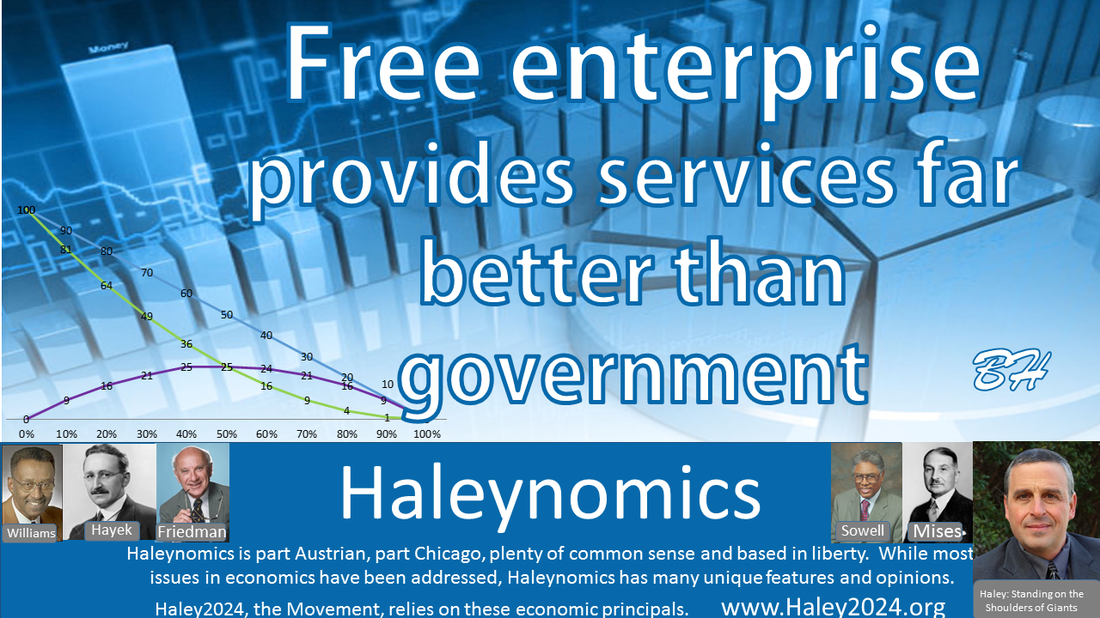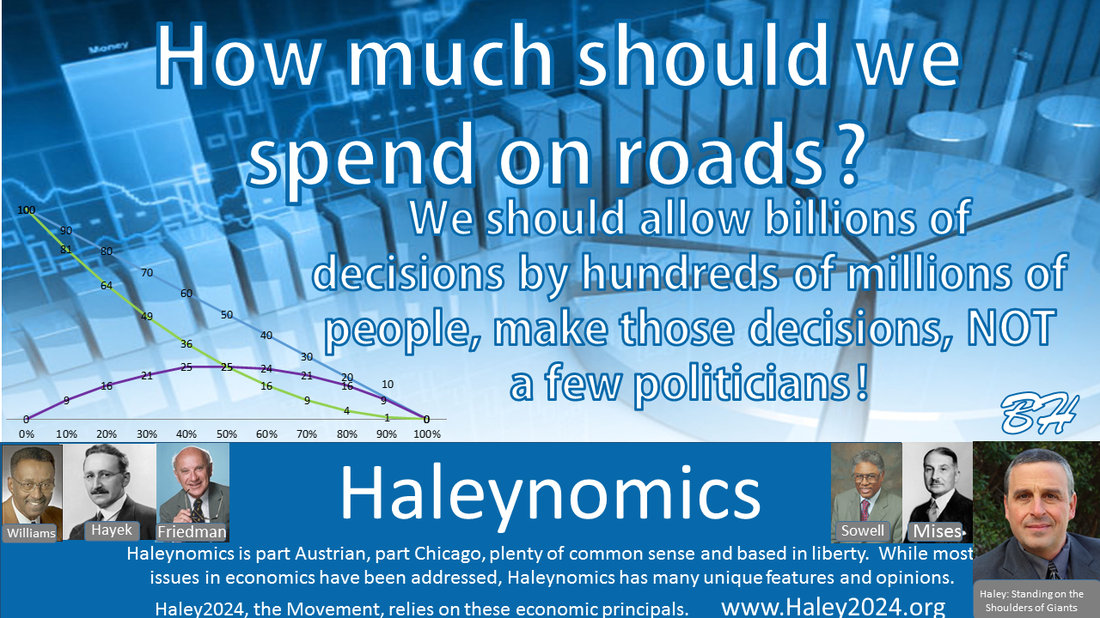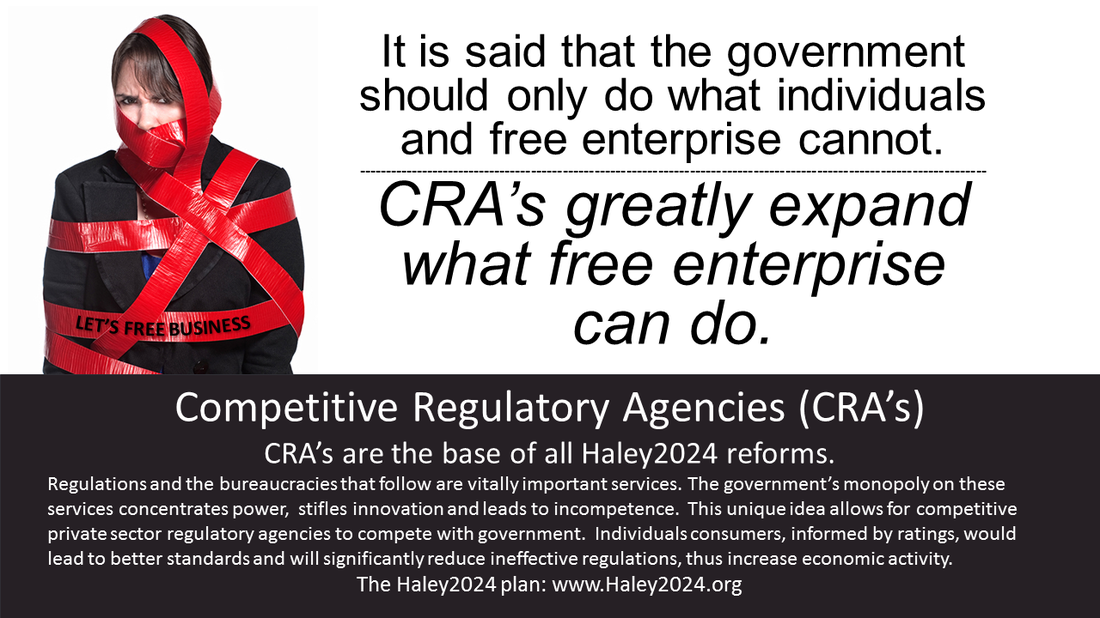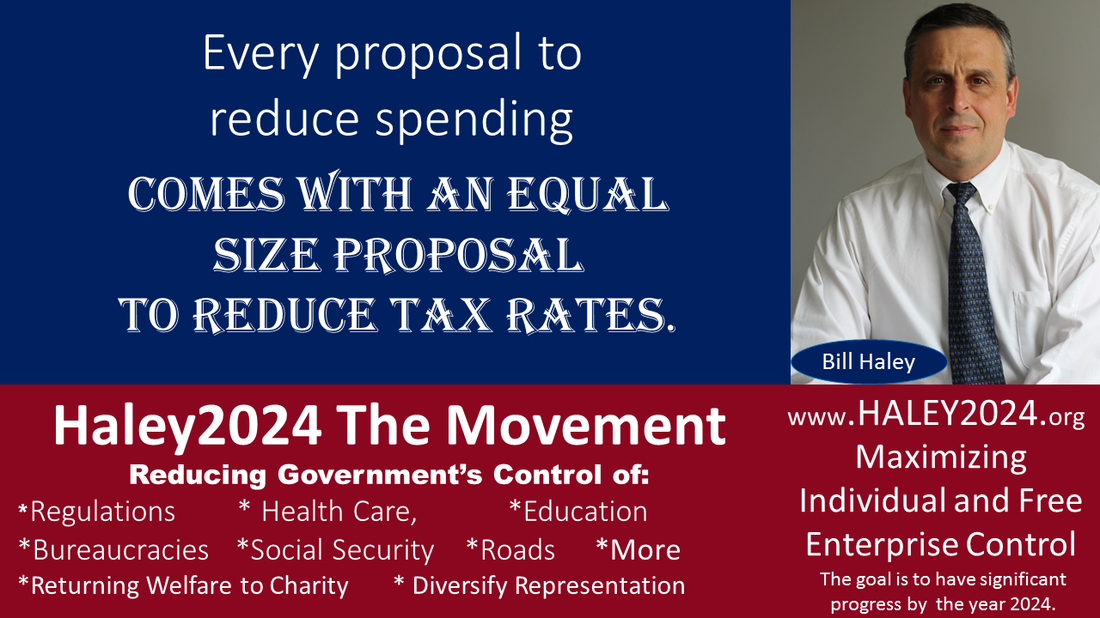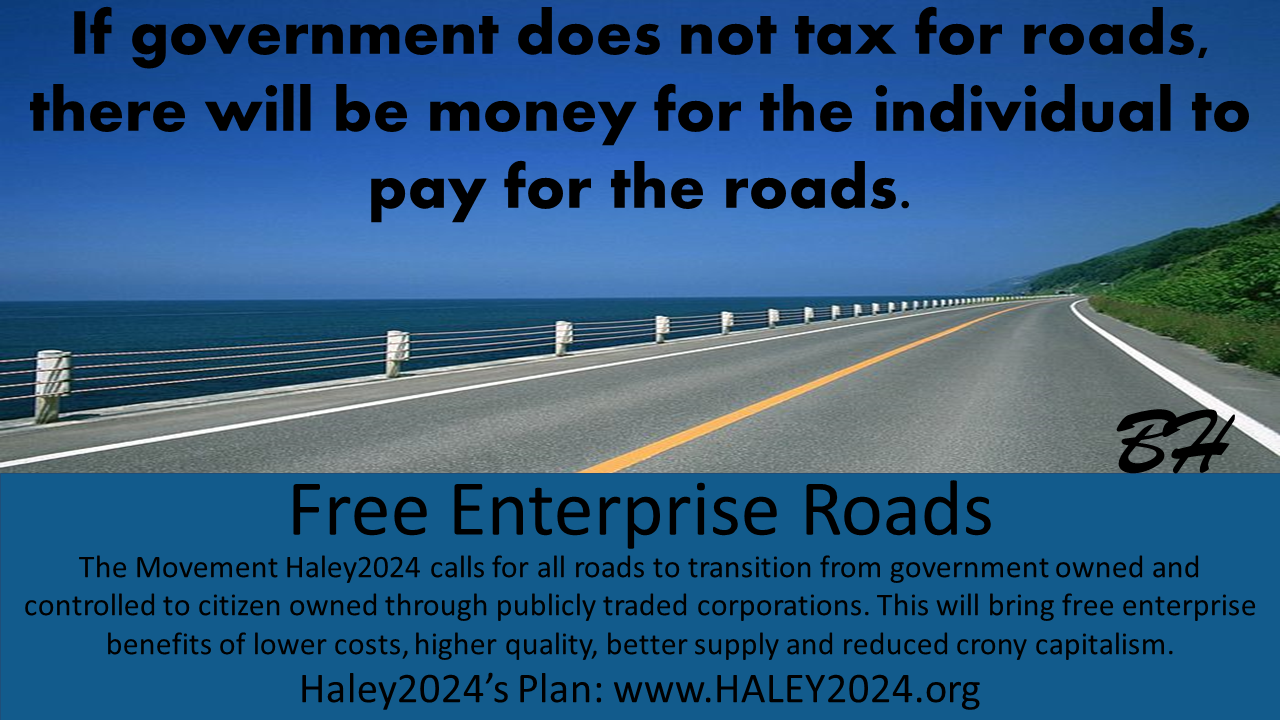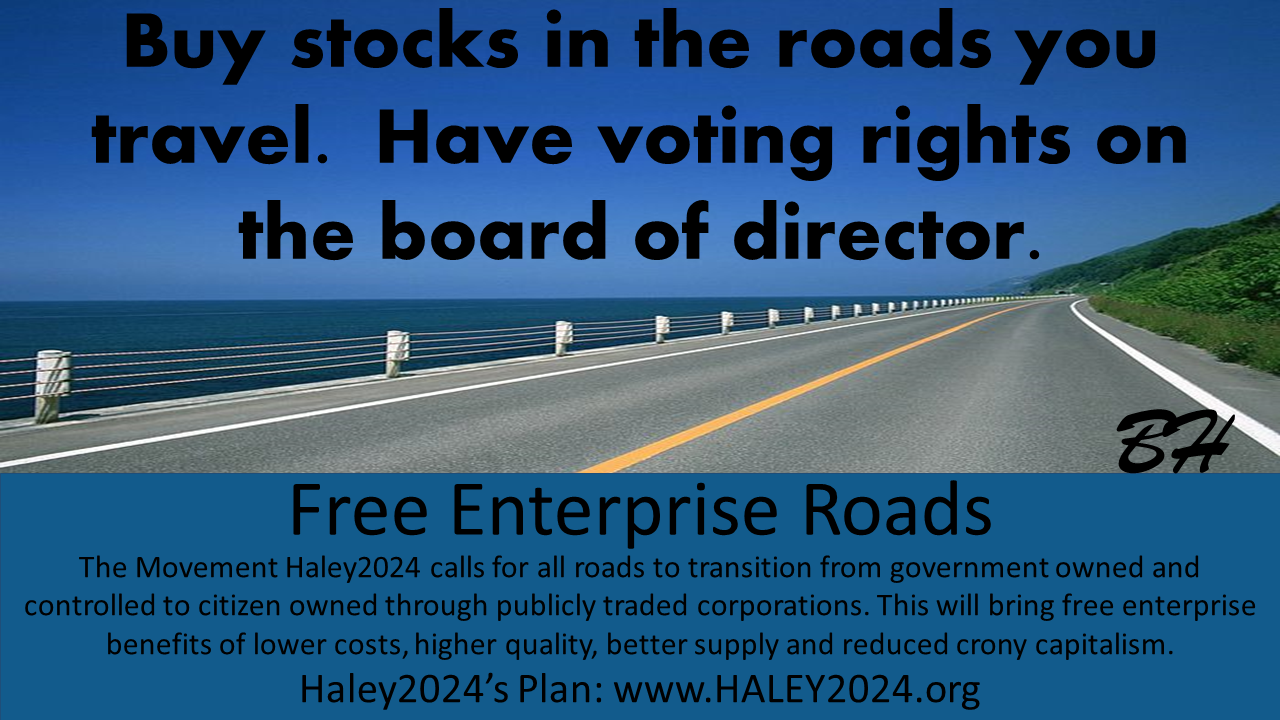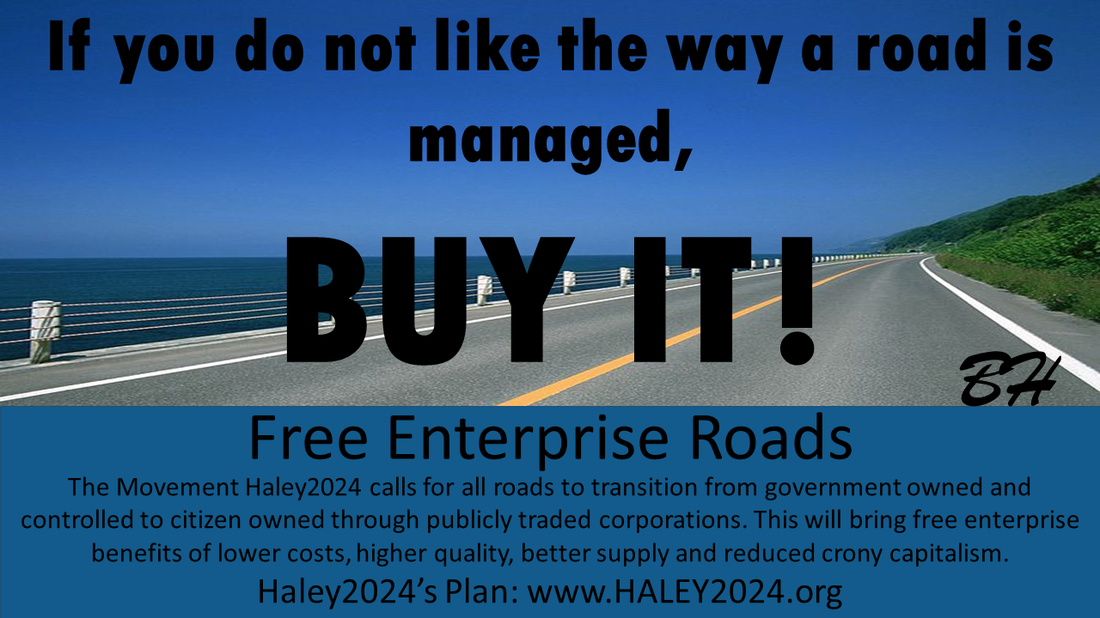The Structure of the Transportation Sector
The bullet points above were updated 9-12-2021. For any minor inconsistencies, please use the updated version above. It remains 98% consistent.
The free enterprise system and the role of prices will improve transportation infrastructure. There is a natural demand for the uses of roads by individuals, businesses, government and the military to travel from one place to another. Whenever there is a natural demand, businesses if not prohibited by the government, will serve that demand.The Movement Haley2024 calls for all roads to transition from government-owned and controlled to citizen owned through publicly traded corporations. This change will bring free enterprise benefits of lower costs, higher quality, better supply, and reduced crony capitalism
|
The Parent Sector Board will determine the scope of the Transportation Sector Board. However, roads, canals, train tracks, and airspace for planes are the focus.The Parent Sector Board defines the scope of all thirty CRA sectors. The transportation sector should regulate all businesses dealing with transportation. The transportation will have a lot of interaction and intertwining with the land and water sector. The federal government will not be involved, so all the states’ transportation sectors must have high ratings on cooperation with other states’ transportation CRA’s. States would be wise to allow the same CRA to operate in many states.
|
The government-owned roads and transportation infrastructure will transition to this structure. This write up will concentrate on roads; however, the others are similar.The three levels of government exert significant control over airports and planes. That control over air travel moves to CRA’s. There is substantial government control over water-ways and boat travel. This control will move to CRA’s in the transportation and land and water sectors. The train and train tracks regulations will also share responsibilities between the transportation and land and water sectors.
|
The Transportation Sector Board and the Land and Water Sector Board including their rating systems are in charge of eminent domain. There MUST be a 70% vote of representatives to allow eminent domain.Eminent domain should only occur in the most important circumstances. 70% of CRA and RA representatives from both relevant sectors will ensure eminent domain abuse is curtailed.
|
The price to force the sale of private property MUST be at least double the fair market value.Haley2024 also proposes doubling the compensation of a forced sale, except for issues of blight which also requires a 70% vote. There is a long history of laws surrounding the ownership of real estate. The owner must pay taxes for law enforcement and city functions in the form of real estate taxes. The maintenance of the property is a requirement of the local government. True blight is the property owner not living up to the requirements of owning property. Under Haley2024, property ownership requires law enforcement contracts among other requirements of other sectors.
|
All government taxes and spending on roads will discontinue.The government will be entirely out of transportation, other than representatives of CRA’s at the sector board level. Representative control is likely necessary for consistent traffic laws and standardized signage. A standardized payment system described below is also regulated by representative control at the sector board level. However, the current government is wholly out of transportation regarding taxes, spending, and regulations. Socialism in the road sector must end.
|
The government will create thousands of private, for-profit publicly traded companies for every government-owned road or set of roads.The proper transition is crucial. Haley2024 proposes that all government-owned roads become assets in new publicly traded corporations. Every road or a logically wise small group of roads will be the main asset in a new corporation. Every state will have thousands of new corporations. A neighborhood might group all the roads in a subdivision.
Having every road business mandated to be a publicly traded corporation is a significant check in the checks-and-balances of this system. Citizens and businesses that buy road services have incentives to buy stocks in the roads they use often. Every road business must become a member of a road CRA. |
The many current private roads will stay under current ownership; however, they must become a member of a transportation CRA.Many roads across America are privately owned. Roads fall into two categories. If the road is open to the public, they must become publicly traded so people can buy stocks in the business. Second, if a business has enough land that they have private roads around their land, and the public cannot freely travel on their roads, they can stay under current ownership. For example, many large neighborhoods with HOA’s often own their own roads.
Disney owns many roads surrounding their theme parks. Private roads in the ‘grey’ areas can stay private if they have high ratings. The issues are many; the representatives from the sector board level will make all final decisions. Many decisions are likely addressed by rating floors before the CRA representatives need to address the issues. |
In the beginning, the government will own all the stocks. Every month 1% of the stocks will be sold on the open market. The sale of road stocks could help pay down government debt.The government-owned roads represent a large set of assets. Those government-owned assets transition from simply owning the roads to owning 100% of the stocks of every new road business, derived from a government-owned road. Dollar-cost-averaging over about nine years will allow the realizations of the true worth of each new road business. It is not wise to dump many trillions of dollars of assets on the open market at a single time. As the Transportation Sector Board collects money for the sale of stocks, government debt is paid down.
|
As long as the government owns the roads stocks, each legislator will have voting rights for a percentage of the stocks that the government owns.During the nine years of government still owning stocks in all these road businesses, there need to be people exercising oversight in the form of voting on the board of directors relating to the stocks still owned by the government. It is not wise to allow the governor or president to have all that power by assigning the power to the executive department. The legislative branch is much more diverse, and each legislator would have only a small fraction of the power inherent in voting on the board of directors.
|
These legislators will have to go through Corporate Proxy Groups, thus giving a buffer against conflicts of interest.This power is further diluted by the mandate that legislators use Corporate Proxy Groups (CPG’s) as a buffer against conflicts of interests. CPG’s are full-time professionals that thoroughly examine every candidate for a board of directors. Every candidate’s record and qualifications are scrutinized. The CPG’s use the voting strength from those that use their services. There are roughly a dozen CPG’s to choose from because they are within the CRA structure. The rating systems from several sectors will give quality information and will have real power to stop abuse, corruption and self-dealing.
|
The sale of stocks and the income from the sale of road services repays road bonds.Many roads still have significant debt in the form of road bonds. That debt is included in the corporation owning the road. That debt will inherently make the stocks of that business worth less. The money collected as a result of selling road services will pay down that debt. If the debt is applied to the overall state debt, the sale of road stocks will bring in more money because the value of the business would increase due to a lack of debt in the business. That increased stock price will result in more money to pay off that debt. Either method works.
|
Many people will see value in owning stocks in the roads they use most often. They will have voting rights for the board of directors and share in profits. The Haley2024 reform of Corporate Proxy Groups will be valuable.Many citizens will buy stocks in the roads they use most often. Voting rights on the board of directors will give citizens most affected by the roads more control over the roads they use. While not mandated, a vast majority of stock-holders are likely to trust and find great worth in turning over voting rights to one of roughly a dozen CPG’s. If the CEO of the road business charges too much, citizens owning the stocks would see greater stock dividends or increase stock values. If the price goes up too much, drivers will find different roads to travel. If the CEO does a lousy job, stockholders will vote them out by changing the board of directors.
|
The Representatives at the Transportation Sector Board controls the payment system with a full system of transponders in the roads and the cars.Many payment systems could emerge to allow each road to collect tolls for their road business. Perhaps a straightforward system of transponders in cars and embedded in roads will be sufficient to have a reliable way of knowing who should be paying and who should be being paid. GPS could be an option, however, has privacy drawbacks. Many people and organizations will propose different payment systems. There is value in having only one system, so if 70% of representatives at the sector board level makes that call, there would only be one payment system. Haley2024 proposes the following payment system.
|
Every car MUST have a transponder to pay tolls. These transponders attained at gas stations are anonymous and not trackable. The motorist MUST reload transponders when getting gas.Haley2024 proposes a transponder system built into the roads and anonymous transponders easily purchased at gas stations for the car. Each time a car fills up on gas, they either reload their transponder or trade it in for a new one. It would be illegal for a car to travel on roads without an active transponder in the car. License plate readers could be a backup system that would only activate if a transponder is not active. Gas stations would have computers and scanners so motorists could settle-up while buying gas. Similar to the current gas tax, motorists must pay for the roads as they fill up their gas tanks.
|
All car rides over transponders are ten cents each. The number of road transponders determines the road’s toll rate. The road’s transponder ONLY knows how many car transponders went over, not the identity of the transponder or the car. The car’s transponder only knows how many road transponders it went over, not which roads it traveled.Every road business will determine their toll. Given that each transponder pass is worth ten cents, the road business will determine how many road transponders they place in their roads. There might be a desire for 5 cent transponders. Heavy trucks might Have to pay extra for the extra wear and tear on the roads thus having two active vehicle transponders. Many factors still need to be worked out; however, this is an excellent base to the system.
|
When a car with a transponder goes over a road transponder, the system transfers funds to the right account.Money is deducted from the car transponder, and the money is added to the road transponder. It is anonymous on the car side; however, the money came from the right person and went to the right road business.
Some people and most businesses will want to keep detailed records of every place they have been. Road transponders are a suitable method. Road transponders will have identifying signals for people that want to keep track. Anonymous transponders do not have that feature. |
Competition from different roads will keep prices in check. Many apps will help people find the most cost-effective and efficient routes.There are many paths to most destinations. Most drivers will factor in the cost of tolls when deciding their directions. Many GPS direction apps already factor in many factors such as congestion or roads under construction. Most GPS direction apps will include pricing. Many people will have a faulty beginning assumption that a road could just charge a $500 toll for a mile ride and drivers would not change to another road to get to their destination. People always change behavior based on price. The role of prices will work if the government or representative control does not have price controls. Consumers impose price controls in the free enterprise system.
|
The Transportation Sector Board will have a system for building new roads.The government system many decades ago used to have a few years from inception to completion of a new road. That government system is now at least a decade and often two decades from inception to completion. This delay significantly increases the cost of a road. The very nature of the CRA system weeds out inefficient regulations and unnecessary costs. Building a new road would bring several sectors together such as the land-and-water and environmental sectors. As long as they are above certain rating levels on many aspects, road projects could be very speedy. RA rating floors would play a more significant role than CRA representative control.
|
Most roads/sidewalks MUST be public places, similar to the current policy.Current public roads turning private does not mean they lose their public place nature. Similar to public right-away, these roads would remain public places. Roads would charge for cars driving on them, but not walkers. Bikers might need to have bicycle-transponders. Interstates and other roads not currently allowing pedestrian traffic could remain that way. Every road is different, but business owners on Main Street want that foot traffic and would likely be big stock owners of the roads in front of their shops. Every public-place scenario is likely to stay the same unless there is a critical reason to change.
|
If most drivers and others in the vicinity of a road are stockholders, they can demand high ratings on beautification.Most people want nice roads and attractive road landscaping surrounding their homes and businesses. Most people will buy stocks in those road businesses. Shareholders could demand better road safety, enhanced beautification, faster pot-hole fixes, snow removal, among other road issues. Stockholders will become acutely aware and understand greater services require more expenses and the resulting increased toll. Everything is a balance, and people will pay for what they desire. This transportation structure allows billions of decisions by millions of people to bring that proper balance, which allows the role of prices to work.
|
The rating system will require high ratings on cooperation with other roads such as intersections.Many people will have a faulty first assumption that the many road businesses would not cooperate. No driver wants to go down a road that does not intersect with other roads. Drivers desire good intersections. The free enterprise system specializes in many people competing to satisfy other’s desire. There will be a rating floor on cooperation; however, very seldom would it be needed.
|
Business owners nearby have a strong interest in good, clean, safe, and nicely landscaped roads.Business owners spend a lot of money making their own property look beautiful and attractive to consumers. These business owners would collectively own a large percentage of the close-by roads. They will have that same motivation for high standard on the roads. Parking spaces, sidewalks, trash cleanup, public bathrooms, among other features are factors in consumers coming to that business district. The current shopping malls have parts of this model and prove that privately supplied roads are beautiful, landscaped, and secured. Single or groups of businesses come together for this purpose.
|
Representatives to the Transportation Sector Board will make all traffic laws and standards on road signage. Representatives set the standards for drivers licenses and car safety standards.It is not convenient to have a dozen different sets of traffic laws. It would be dangerous for some roads to have a drive on the right regulation, and other roads regulate that cars drive on the left. Green should always indicate go, and red should always specify stop. Shapes of signs should be consistent on every road. The representative sector board level should decide the regulations and standardization of specific issues. Standards for car safety and driver qualifications must be uniform across all roads.
|
Identification cards are the responsibility of the Identity CRA Sector. A person’s digital identity card holds all certifications, degrees, and licenses, including the driver’s license.The transportation sector sets the standards for a driver’s license; however, every person’s identity company and their identity CRA issues the license. The need for the current DMV offices would likely be minimal. The competition for those DMV services would yield more convenient business models as transportation CRA, and identity CRA handles those issues. The competition among CRA’s would drive out inefficiencies and delays. CRA’s would allow higher prices for better services.
|
Every road business must contract with a police business to patrol the roads.The reform of law enforcement to free enterprise police requires every business owner to provide law enforcement for their business. The roads also will need to contract out with a law enforcement business. Law enforcement businesses will need to contract with many home-owners, business-owners and other businesses. Road business law-enforcement contracts are one source of income to free market law-enforcement budgets.
|
|
|




